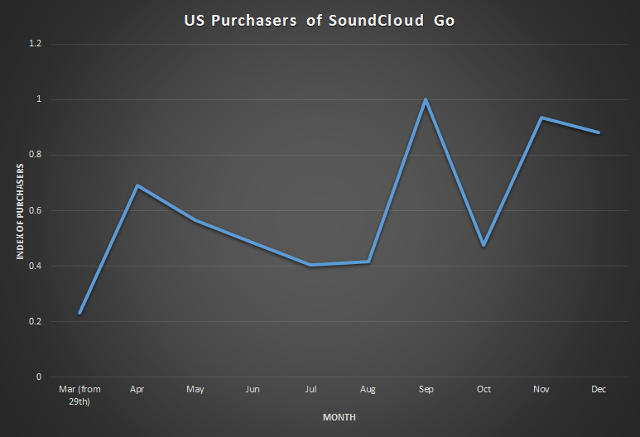SoundCloud Vows Growth In 2017, But Time Is Running Out
SoundCloud is having a transformative moment about two years behind schedule. As the music streaming service approaches the first anniversary of its paid music subscription tier, revenue is growing, but so are losses. The Berlin-based company now faces the two-pronged challenge of turning its finances around and remaining competitive in an increasingly crowded marketplace. Despite the daunting prospects, CEO Alexander Ljung tells Fast Company he’s looking ahead with big ambitions, healthy projections, and a renewed sense of hope. With its subscription business finally off the ground, Ljung says, SoundCloud is just getting started.
Now it just needs some cash.
“[Last year] was really putting a lot of key pieces into place,” Ljung says, adding optimistically that 2017 “is going to be a big year, especially in terms of revenue growth.”
You might not agree if you’ve been paying attention to the news. Earlier this week, SoundCloud posted a loss of $52 million for 2015, a year in which costs mounted as it buttoned up pricey licensing deals for its subscription service. But since then, revenue growth has accelerated, and the company expects more progress this year. In 2017, Ljung says, revenue is projected to grow 137% over last year. That’s a big jump from 2015, when revenue climbed about 21% from 2014 as losses deepened.
But even if SoundCloud beats its own projections, it may not be enough to offset the infamously sizable costs of licensing music from labels and rights holders. SoundCloud faces a precarious path forward, with the Financial Times warning that the company could run out of money by year’s end if it doesn’t raise more. Indeed, Ljung says, SoundCloud is in the process of exploring a new round of funding with investors. Not only is the clock ticking, but competition for music subscription dollars is heating up fast: Amazon, Apple, YouTube, Pandora, and Tidal all entered the music subscription market while SoundCloud was preparing its own foray.
That finally happened last March when the 10-year-old startup announced SoundCloud Go, its long-rumored $10-per-month subscription tier, launching first in the U.S. and then expanding to seven other countries. Over the last year, SoundCloud has focused on trying to scale its subscription business while making modest improvements to its product, like the addition of personalized radio stations.
The changes came amid ongoing reports of a potential sale of the company. In 2014, Twitter explored the possibility of buying SoundCloud, but the social network reportedly walked away from the talks. Last year, rumors surfaced that Spotify was in talks to snatch up the service for a reported $1 billion, again to no avail. Bloomberg reported that those negotiations fell apart over disagreements about the price, but some credible chatter in the music streaming world suggests that the margin economics and complex integration of such a deal wasn’t palatable to Spotify as it prepares to go public this year. Now Google is reportedly mulling a $500 million acquisition of SoundCloud.
Not surprisingly, SoundCloud won’t comment on acquisition rumors, nor will it divulge its total number of subscribers, although it says that since SoundCloud Go launched, users have spent an average of 36 hours per month listening to the new premium service. The silence on its subscriber count is telling: Any service with explosive growth in sign-ups would likely be eager to tell the press about it. Instead, the only tangible hint SoundCloud has offered was a promotional discount announced in September, offering three months of service for $1 in the hope of boosting subscribers.
A SoundCloud Go account includes access to a sizable library of licensed music and offline listening, but offers little to lure subscribers away from the likes of more mature services like Spotify or Apple Music, both of which grew substantially last year (and happily bragged about it). By summer 2016, new SoundCloud Go signups had dipped about 40% from their April spike, according to data from third-party analytics firm JumpShot. Those numbers shot back up with SoundCloud’s autumn discount campaign, which helped the company close out the year with a higher sign-up rate than it saw for most of the year.

It’s still quite early for SoundCloud Go and, as Ljung is quick to point out, for the phenomenon of streaming music in general. All told, about 100 million people subscribe to paid music services worldwide, a relatively new trend that shows no sign of slowing down.
“It’s growing extremely rapidly,” Ljung says of the music subscription market. “For us, what that means is that 2017 is this exciting year of finally being in a market that’s growing very rapidly.”
While SoundCloud has struggled to establish itself as a true business, it remains a major and uniquely positioned player in terms of its scale, the breadth of its music catalog, and its cultural relevance. When it comes to creators or content metrics, we’re radically bigger than anything else out there,” Ljung says.
And he’s right: Boasting 175 million unique listeners and 135 million tracks, SoundCloud is one of the biggest music streaming platforms on the planet. Its origins as a free, user-generated music service means it not only has a ton of music not available anywhere else, but that it’s a platform where artists and fans can interact directly. It has long been a place where up-and-coming artists blow up before they land on services like Spotify and Apple Music. If you’re reading about the hottest, about-to-break artist on a music blog, chances are the accolades are accompanied by a SoundCloud audio embed.
But it’s not just indie bedroom songwriters and aspiring rappers: Superstars like Drake, Kanye West, Chance the Rapper, and many others use the service to upload tracks, sometimes posting material that isn’t available elsewhere. The massive repository of original, artist-uploaded music is something that no other company, no matter how massive or well-funded, could easily replicate. And Ljung knows it.
“The spark of how culture and creativity gets started tends to be on SoundCloud,” Ljung points out. “We play an enormously important role as the platform where culture and creativity is getting defined.”
Moving into 2017, it’s clear that this unique fan-to-artist connection is something SoundCloud hopes to capitalize on further. “Because we have so many more creators than other platforms and we actually have a presence from the artists, we want to look more at that,” Ljung says. “How do you differentiate the service even more, so people can get even more exciting, differentiated content?”
Indeed, SoundCloud’s credibility and popularity among artists may organically provide an opportunity that others have had to pay millions for: The ability to offer new and unreleased music from prominent artists. Call it the poor man’s streaming exclusive. But it’s one of the things that could help SoundCloud set itself apart while the business pressure heats up from pretty much every direction.
For SoundCloud, its attempted transformation into a subscription service is widely considered to be the company’s only viable shot at making money—or at least attracting a buyer willing to commit to what its executives consider a reasonable price tag. Earlier attempts to weave advertising and premium tools for artists into its business strategy have evidently not reaped enormous amounts of revenue, which isn’t a shock considering that ad-supported free music streaming remains a relatively sluggish business while paid subscriptions are exploding. Last year, on-demand audio streams increased 82% over 2015, according to music analytics firm BuzzAngle. Streaming is quickly becoming a dominant slice of the revenue pie for the recording industry, a crucial factor driving the 8.1% increase in revenue labels saw during the first half of 2016.
At this point, not even a massive influx of paying subscribers would necessarily save SoundCloud. That’s because the streaming music business remains a challenging one in general; neither Pandora nor Spotify have turned a durable profit, while giant competitors like Amazon, Apple, and Google can afford to run music services at a loss. SoundCloud Go even finds itself lagging behind smaller players like Tidal, which offers perks like high-fidelity audio quality and a host of exclusive releases from blockbuster artists like Rihanna, Kanye West, and Beyonce. This strategy has helped Tidal amass over 4 million subscribers, but it hasn’t led to profits (especially since these deals with high-profile artists are presumably quite expensive). Like SoundCloud, Tidal is frequently rumored to be in talks with potential buyers.
While the general economics of streaming and music subscriptions continue to shake out, SoundCloud at least has a seat at the table and plenty of unique characteristics that can help it boost revenue, entice investors, and—perhaps inevitably—seduce a buyer.
“It is a challenge coming later into the subscription market,” Ljung admits. “I would have loved to have had that happen earlier. You could say that about anything, I guess.”
Fast Company , Read Full Story
(97)



